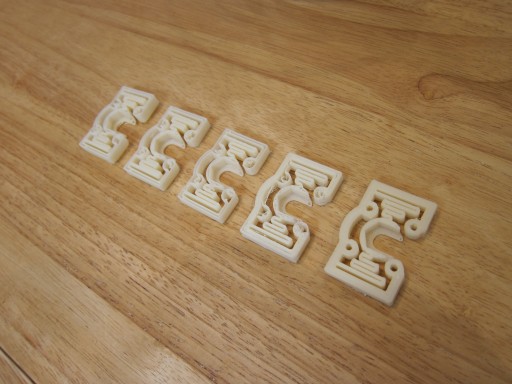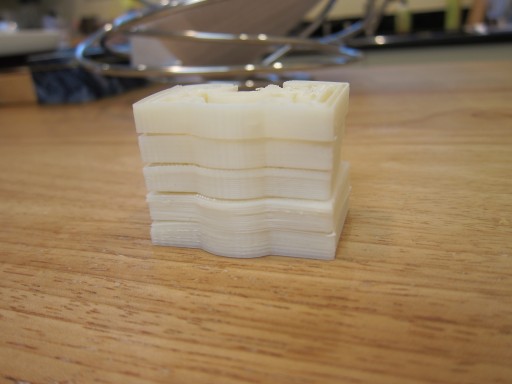I recently built a Makerbot, and have been working on getting it to print nice-looking objects. This was an interesting learning process, and I thought I’d outline what I did, in case it is of interest. Most of the effort was in configuring a software tool called Skeinforge, a program that will take a 3D model, and interpret it as instructions to a 3D printer.
I really wanted to print a piece called a “Z-Axis Wobble Arrester”, an upgrade that improves output from the Makerbot. I was to discover that this is actually a very difficult piece to print, due to the narrow walls and fine tolerances of the “springs”.
Here is a picture of various “drafts” of the piece:
The earliest attempts are on the left, getting steadily better until I got to the part on the right, which is actually functional. Keep reading for a summary of the process I went through to get to a finished part…
The first part used the Makerbot default settings, the ones that will be in use if you install skeinforge 0007 and select the “Makerbot ABS” profile. Layer height is .35mm, feed rate is 25mm/s and extrusion width over thickness is something like 1.8. While the the geometry is perfect, and the layers are laid down perfectly, parts that should be solid are hollow! The good news, even with this first print, is that the Makerbot hardware was working perfectly – very precise layers, excellent adhesion, very little warping. This reassured me that the issue was in the skeinforge configuration, not in the hardware.
I figured that the skeinforge was thinking that the extrusion was thicker than it actually was, and so I should tinker with the extrusion width over thickness setting. So I changed that 1.6, thinking that now skeinforge would think there was room for more plastic. This led to the second part. As you can see, the solids are still hollow. For this part I also set the raft interface layers to 0, which made it much easier to detach. At this point I also realized that the skeinforge preview gives you a very accurate sense of what the print will look like, and whether or not the solid areas will actually be filled. This significantly sped up the configuration process, since I didn’t actually have to print to make settings changes.
For the third part, the biggest change, based on suggestions from the Google Group, was to reduce the layer height to 0.28mm and increase the feed rate. This has the effect of making the filament smaller. I may also have tinkered with the “extra shells on sparse layers” setting. The third print was an improvement – the “springs” are clearly separate, whereas in the first and second prints they were solid and didn’t really flex.
For the fourth part, I increased the feed rate even more aggressively: layer height of .28mm, feed rate of 40mm/s and width over thickness of 1.3 or so. This finally started to fill in the solid parts of the sides, though the area around the screw holes is still hollow. This was shown clearly on the skeinforge preview, I should have believed it. I also switched to the modified wobble arrester model with thicker sides, thinking that this would help.
Finally, for the final piece, the critical change was a parameter in the Inset module, for overlap removal. Apparently this will prune extrusions that are too close to previous ones – however, it was actually removing extrusion paths that were necessary. I changed this parameter to 0.1, to disable it, and changed the extrusion width over thickness to 1.4. Extra shells on base layers and sparse layers went back to 3. This print was very successful. The walls are filled in with concentric shells, not the fill pattern, so it is very solid. The springs flex well.
However, there is a price:
The earlier prints are on the top, and the later prints are on the bottom. As you can see, the prints with a layer height of .35mm and a feed rate of 25mm/s are much more regular. I suspect that forcing the Makerbot to work faster makes it sloppier. I will be working on trying to achieve a happy medium: solid walls, with the kind of Z-axis quality you see in the earlier prints.
You can also see warping in the pieces, they are curved at the ends where they pulled away from the build platform. This is partly due to my impatience, since I peeled them off the platform while they were still warm, but is generally a known issue. I think this will be solved by installing a heated build platform.



[…] MakerBots and RepRaps proliferate, so do the websites and content concerning them. Gian Pablo Villamil had a really great post about his adventures with Skeinforge. As with BotHacker’s excellent post about the Skeinforge Cool setting and analysis about […]
[…] MakerBots and RepRaps proliferate, so do the websites and content concerning them. Gian Pablo Villamil had a really great post about his adventures with Skeinforge. As with BotHacker’s excellent post about the Skeinforge Cool setting and analysis about the […]
[…] Calibrating Skeinforge Making a MakerBot Part 1 Making a MakerBot Part 2 Terminal Block Making a MakerBot Part 3 Heated Build Platform Making a MakerBot Part 4 – Paxstruder by Bre Pettis | Categories: MakerBot in the Wild | Enjoyed this article? Subscribe to the full RSS Feed […]